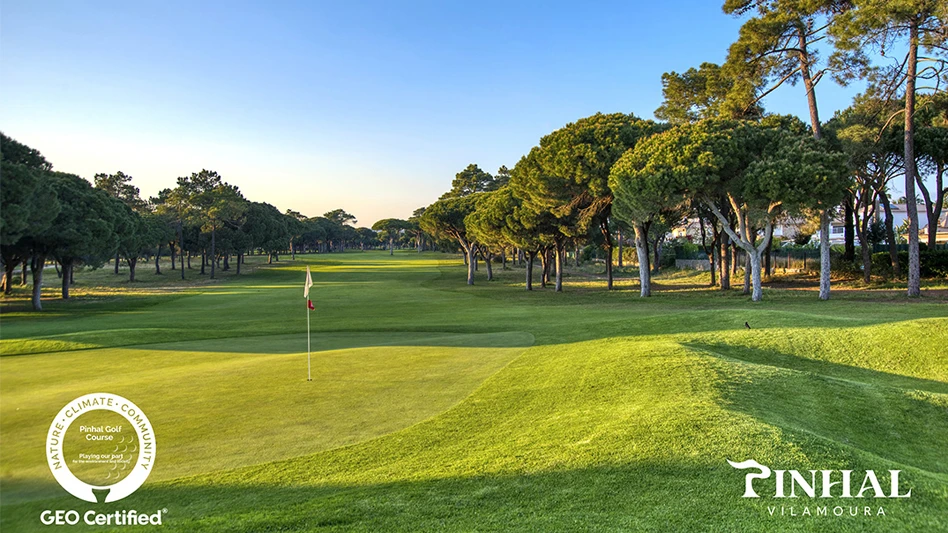When Lakewood Country Club in Rockville, Md., reopens next spring following an almost-two-year renovation project, its tees and fairways will be sporting bentgrass rather than the perennial ryegrass the course had used for many years. The main reason for the turf change is the absence of a perennial rye variety that was resistant to gray leaf spot, a fungus that has wreaked havoc on many perennial rye courses for the past 15 years.
“Had it been available, we would probably still be a perennial ryegrass course,” says Chris Ayers, superintendent of the private, 18-hole transition-zone course located just outside Washington.
Fewer transition-zone courses are using perennial ryegrass these days because of gray leaf spot, which can quickly wipe out a stand of perennial ryegrass, according to Terry Buchen, president of Golf Agronomy International, a Williamsburg, Va.-based turfgrass consulting firm. But Ayers and fellow superintendents now might have the option of returning to one of their favorite grasses, thanks to the work of Rutgers University researchers led by Drs. William Meyer and Stacy Bonos.
|
|
The Paragon GLR, Repell GLS and Palmer IV varieties of perennial ryegrass recently hit the market, according to Bonos, an assistant professor of turfgrass breeding at the New Jersey school, which has been developing the gray-leaf-spot-resistant varieties since 2000.
“The germplasm is a major step forward in bringing perennial ryegrass back into favor with golf courses,” says fellow Rutgers professor Bruce Clarke.
Root of the problem
Gray leaf spot is a strain of the same fungus that causes rice blast, one of the major agricultural diseases in the world, according to Clarke. On perennial ryegrass, it starts as small, oval leaf spots that are yellowish-brown on the margins with a tan center. When humidity is high, the leaf spots become felty with gray spores, which the wind can transport long distances.
“It is a major problem on golf courses because they overseed with perennial ryegrass and the seedlings are very susceptible,” Clarke says. “It is about as quick as pythium blight in killing turf. It often starts in the roughs and will move via wind and rain into fairways, which become strongly affected as well, especially if they are oveseeding, watering and fertilizing the new seedlings.
“The fungus likes high moisture and humidity,” he adds. “The perfect temperatures are nights in the 60s and days in the mid- to upper-80s. You tend to see it from late July through October. The worst time is in August and September when courses are overseeding.”
|
|
The fungus began attacking annual ryegrass in the 1970s, according to Bonos and Clarke. Dr. Peter Dernoeden, professor of turfgrass pathology and weed management at the University of Maryland, first noticed it on perennial ryegrass in 1985. Pennsylvania State University professor Peter Landschoot identified it as gray leaf spot in 1992. It soon spread throughout the country, with major epidemics occurring in 1992, 1995 and 1998. Primarily a problem at transition-zone courses east of the Mississippi, the fungus has been reported in Kansas and Nebraska and identified as far west as California. It also has been reported as far north as New Hampshire and as far south as Georgia.
ProSeeds Marketing is working with the Northern California Golf Association on a series of gray-leaf-spot-resistant perennial ryegrass trials in San Diego, Sacramento and Pebble Beach, according to Craig Edminster, ProSeeds marketing director.
“For the last six years, the focus has been on the mid-Atlantic region, however, you have gray leaf spot all over right now,” Edminster says. “There is a lot of rice production in California, and Pyricularia grisea, the fungus of gray leaf spot, is a problem on rice, so there’s a huge host in California. Two years ago no one ever imagined it would be a problem in California.”
ProSeeds is marketing Palmer IV and will soon be introducing several additional gray-leaf-spot-resistant perennial ryegrasses.
Seed Research of Oregon technical agronomist Skip Lynch says Dernoeden once was asked how damaging a gray-leaf-spot outbreak could be.
“He called it the ebola of perennial rye, which speaks to the rapid destruction it can cause,” Lynch says.
Dealing with it
Not only does gray leaf spot spread easily, it can cause extensive turf loss and requires preventive measures. Ayers began seeing gray leaf spot problems on his course in 1995.
“We learned a little more about it every year,” he says. “With different rates and different products, we tried to prevent it. We got better and were able to minimize the damage. But we felt like we were always going to be susceptible to it. Throughout the years, we took out the ryegrasses in our rough mix. It seemed like the gray leaf spot always started just outside the irrigated rough and crept its way into the shorter grasses. We started applying products to the rough to keep it from getting into the fairway. It was getting to be a pretty expensive proposition with no 100-percent guarantee that we could keep it down.
|
|
“When we made the decision two years ago to renovate the course, there was some slight mention that these [gray-leaf-spot-resistant perennial ryegrass varieties] might be coming down the road,” he adds. “But there was no guarantee. With the time and effort we were putting into this renovation, and considering our location in the mid-Atlantic, switching to bentgrass seemed like the right thing to do.”
Gray leaf spot also can require superintendents to use large amounts of fungicide for control, which led Ayers and other superintendents to switch to bentgrass. Still, the decision to switch from perennial ryegrass was a tough one for Ayers and other superintendents in the transition zone who made similar decisions.
“There is no perfect grass,” Buchen says. “One that does well in the summer won’t do well in the winter and vice versa. Zoysiagrass, Bermudagrass, bentgrass, ryegrass or bluegrass are the choices in the transition zone. Perennial ryegrass does really well because it can handle the heat and humidity in the summer, but stays green all winter.”
Other than gray leaf spot, perennial ryegrass has a lot in its favor, according to Ayers.
“Playability, quick germination and appearance were always positives,” he says. “You didn’t have to collect clippings on fairways when mowing, so it could be a labor-saving grass. Some of the Poa annua-control products allowed us to control Poa in the perennial ryegrass fairly easily. It was a durable grass and could withstand cart traffic. It was an all-around good grass for us.”
New developments
Despite all the positive aspects of perennial ryegrass, all commercial varieties of it were susceptible to gray leaf spot, which led researchers on their quest for resistant grasses.
“If you have a susceptible variety, it will take it right down to the ground,” Bonos says. “It generally attacks seedlings from a week to four weeks old.”
Rutgers researchers first noticed gray leaf spot at its research farm in 2000. They found a few germplasm sources that were resistant, selected them, increased their numbers and intercrossed them.
“The next year, we got another infestation of gray leaf spot and were able to see if the selections had improved resistance to gray leaf spot,” Bonos says.
“They did. Every year since then, we have been getting gray leaf spot and have been able to select for improvements every year.”
The resistant selections contain a specific gene or set of genes that confer resistance.
“We are still unsure whether it is just one gene or a few genes,” Bonos says. “But based on the classical genetic research we have done so far, the resistance does not seem to depend on a large number of genes.”
The fact that resistance likely involves multiple genes is important as well.
“If the resistance is dependent on just one gene and then the fungus race changes, which is known to occur frequently in rice, the resistance will easily break down,” Bonos says. “If it is dependent on more than one gene, the resistance should theoretically last longer. So far, we have not seen any breakdown in resistance or race change in the fungus. That is not to say that it won’t happen. We are incorporating a large diversity of germplasm sources in our selected populations as a strategy to try to maintain a more stable resistance.
“If everything keeps going the way it has, you can plant perennial ryegrass again,” Bonos adds. “But you cannot predict what pathogens might do. If the fungal race suddenly changes, you are back to square one again. We are trying to prevent that from happening by selecting from a large germplasm base.”
A perennial return
With sufficient supplies of gray-leaf-spot-resistant perennial ryegrass becoming available thanks to research, Bonos and others expect the grass to become a favorite at transition-zone facilities again.
Turf Merchants is marketing Paragon GLR. And ProSeeds’ Palmer IV is on the market and will be available in large commercial quantities in 2005, according to Edminster. Other ProSeeds gray-leaf-spot-resistant products coming to market soon include Panther GLS, Repell GLS, Prelude GLS and Palmer GLS (available in 2006-07).
“We apparently have the whole package with these varieties,” Edminster says. “They still have great turf quality, yield high numbers of seeds, are all dark green and have multiple-pest resistance.”
|
|
Lebanon Turf Products has three new perennial rye varieties with gray leaf spot resistance it plans to introduce during the next two to three years, according to turfgrass marketing manager Murray Wingate. Seed Research of Oregon has six varieties on or coming to market that were bred for gray leaf spot resistance, including SR4220, SR4550 and Peregrine.
“Those three varieties are also very salt tolerant,” Lynch says. “You almost never plant perennial rye straight. It is usually part of a blend. A good blend can have gray leaf spot resistance, salt tolerance and attractive color.”
Ayers says he will still use some ryegrass at Lakewood.
“In our area, it is the best first-cut of grass off the fairway,” he says. “If the gray-leaf-spot-resistant ryegrasses come on the market, we’ll use them in that area. The driving range tee, because of perennial rye’s quick germination, could be switched to perennial rye down the road. The fairway on the range itself could also someday be perennial ryegrass.
“It has advantages,” Ayers adds. “But, as anyone who has grown grass in the transition zone knows, there is no silver bullet among fairway grasses. Within 10 miles of my course, you can find ryegrass, zoysiagrass, Bermudagrass and bentgrass courses. There is no perfect grass. You go for the one with the fewest evils.”
Additionally, the gray-leaf-spot-resistant varieties could cost slightly more than traditional perennial ryegrasses.
“The premiums won’t be huge, but there will be some, particularly if it can be proven that these are resistant in the field,” Edminster says. “Documented gray-leaf-spot resistance will probably pull a premium in the marketplace. If I was a superintendent with gray-leaf-spot problems, I wouldn’t mind paying a penny to a nickel more per pound for a perennial with gray-leaf-spot-resistance compared with one that was susceptible.” GCN
Peter Blais is a freelance writer based in North Yarmouth, Maine. He can be reached at pblais@maine.rr.com.
Get curated news on YOUR industry.
Enter your email to receive our newsletters.
Explore the November 2004 Issue
Check out more from this issue and find your next story to read.
Latest from Golf Course Industry
- From the publisher’s pen: New? No way!
- Indiana course upgrades range with synthetic ‘bunkers’
- Monterey Peninsula CC Shore Course renovation almost finished
- KemperSports and Touchstone Golf announce partnership
- PBI-Gordon Company hires marketing manager Jared Hoyle
- Mountain Sky Guest Ranch announces bunker enhancement project
- GCSAA names Joshua Tapp director of environmental programs
- AQUA-AID Solutions bolsters Sunshine State presence










